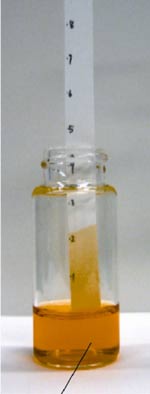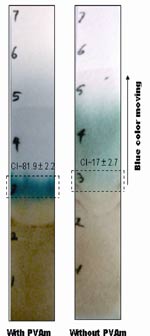
Canadian Group Develops 'Dipstick' Test for Pesticides in Foods

A test strip shows a visible color change indicating the presence of pesticides, and advance toward a dipstick test for foods and beverages.
Photo courtesy of The American Chemical Society.
Scientists in Canada are reporting the development of a fast, inexpensive 'dipstick' test to identify small amounts of pesticides that may exist in foods and beverages.
Their study was published in the American Chemical Society's Analytical Chemistry, a semi-monthly journal. John Brennan, Ph.D., of the Department of Chemistry and Chemical Biology at McMaster University in Hamilton, Ontario, and his colleagues describe the development of a new paper-based test strip that changes color shades depending on the amount of pesticide present.
In laboratory studies using food and beverage samples intentionally contaminated with common pesticides, the test strips accurately identified minute amounts of pesticides. The test strips, which produced results in less than 5 minutes, could be particularly useful in developing countries or remote areas that may lack access to expensive testing equipment and electricity, they note.
'Reagentless Bidirectional Lateral Flow Bioactive Paper Sensors for Detection of Pesticides in Beverage and Food Samples' is available on the American Chemical Society's Web site as a pdf.